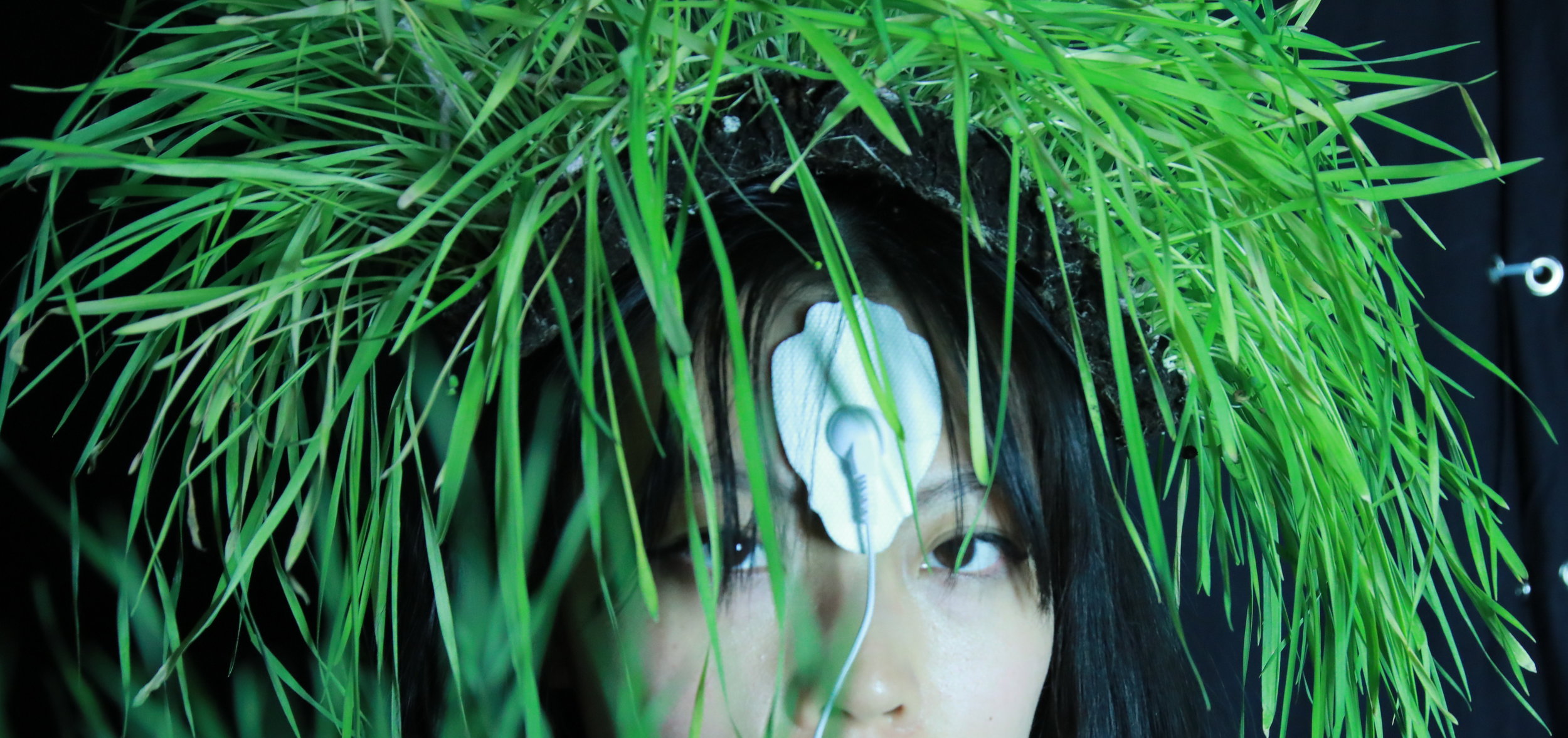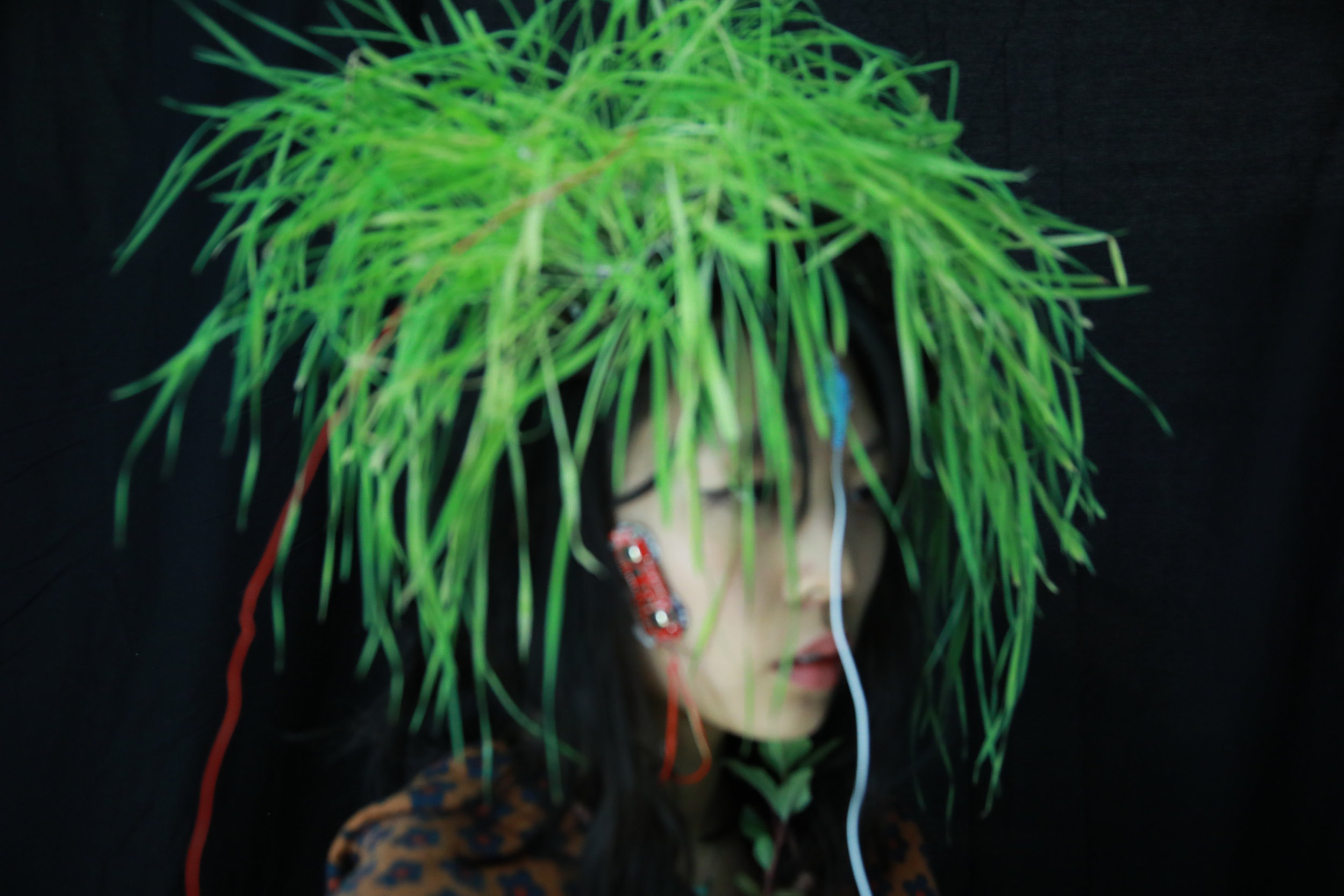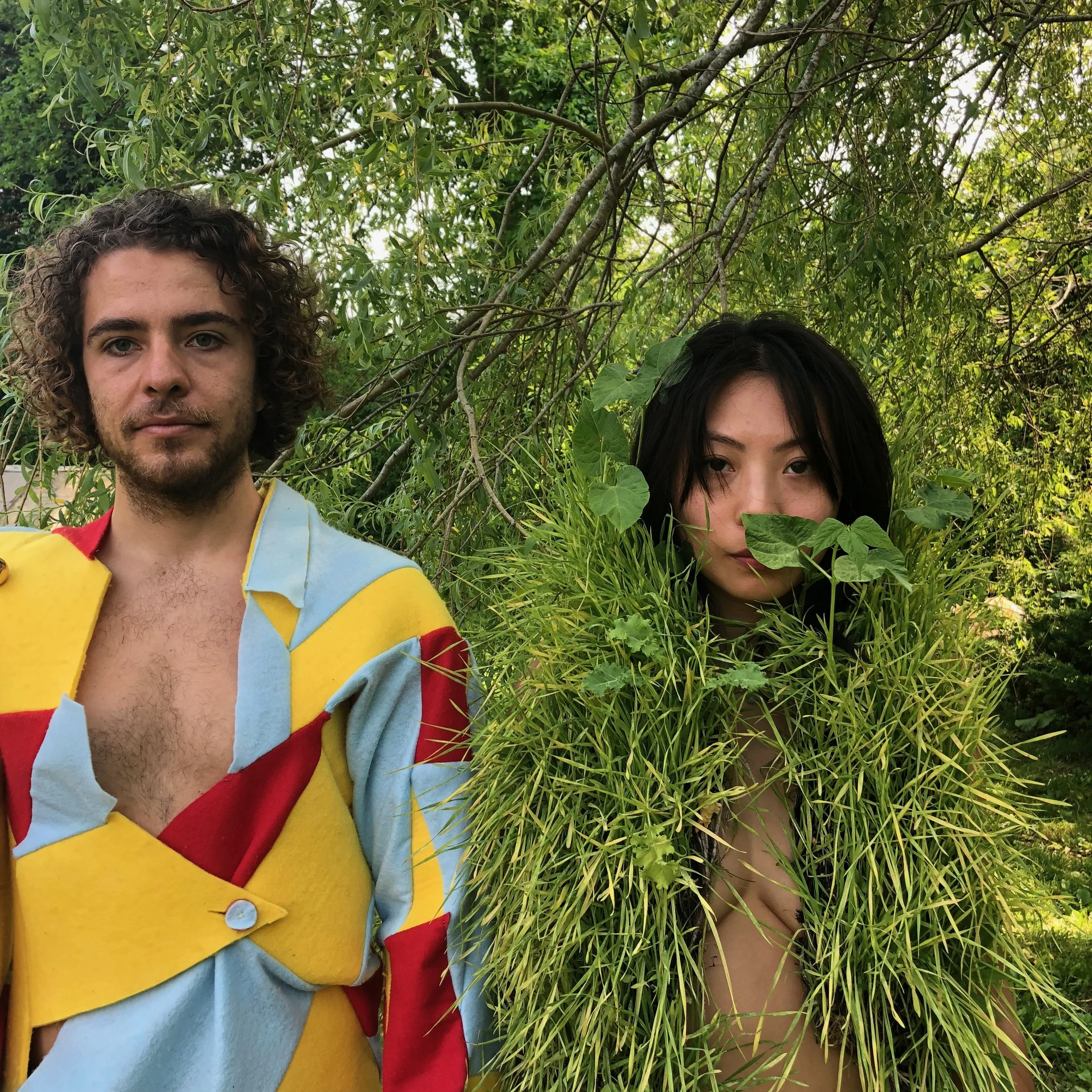Phytobionic: Plant-Human Interfaces and Symbiotic Metamorphoses
The budding field of plant neurobiology alludes to the possibility of new forms of plant-human symbiosis. Plants are now known to be capable of rapid responses to environmental conditions, as well as complex adaptive, and social behaviors (1). These responses are mediated by neurotransmitters, or molecular analogs, air-born pheromones, as well as electrical signaling. At the molecular level, plants have most of the same components found in animal neuronal systems. Plant electrophysiology is detectable with electrodes and can be used to visualize plant-responses to stimuli, such as sound, light, spacial orientation, predation, wounding, and water stress (2), and can be characterized as either action potentials (AP), short pulses of electrical activity after membrane depolarization, or variation potentials (VP), slow-wave signals that follow hydraulic pressure change through the xylem (1,3). APs are formed through the action of calcium, chloride, and potassium ion channels, while VPs and believed to involve the temporary cessation of P-type H+ ATPase, in addition to as of yet unknown ion channels (3).
Both APs and VPs can trigger distinct chemical and morphological changes within plant tissue, leading to changes in growth, gene expression, or in the case of climbing plants, movement. Although the social behavior of plants, operating through mycorrhizal networks, is well described, anthropogenic definitions of intelligence have relegated investigations into plant neurobiology, and as an extension phytosemiotics (4). The disconnect between the perceptions of plant intelligence and the realities of their behavior is largely due to differences in the timescale over which plant behavior takes place, as well as their sessile evolutionary strategy (5). This difference can be partially overcome by time-lapse analysis of movement (5), and possibly time-lapse electrophysiological recordings using patch electrodes.
Mimosa pudica reacting to touch stimulus in my apartment. This produces a cascade of action potentials changing the hydraulic pressure inside the leaf causing motion.
Human society has become increasingly fast paced, and focused on the immediate fulfillment of desires, often at the expense of both the environment and human happiness. The unique challenges of the anthropocene require that we allay ourselves with plants in the formation of symbiotic super organisms, creating patterns of being guided by plant survival strategies (Low energy living, slow adaptive growth, and soil building). This coevolution reformulates the relationship between human and plant from predator-prey, to co-regenerators linked through a celebration of mutual reliance; The phytobionic self acknowledges the supremacy of plantae as guides in the search for earthly meaning, as translators of sun strength, interpreters of the radiant dawn. Below is an early example of a participant in ritual symbiosis.
Phytobionic proposes a vision of a future earth. With joy, the human body becomes an extension of plant consciousness, a sense organism within the matrix of green terraformers. In the phytobionic, the phytobiont (the plant organ), exerts an inexorably pull on the sapiobiont, experienced through neuro-electrical stimulation, transcutaneous electrical muscle stimulation, or direct biochemical flow of shared neurotransmitters mediated by a mycorrhizal cyborg translator/blood-phloem barrier. Similarly, human neurobiology is sent to the plant in the form of electro-stimulation, shaping plant morphology through biofeedback. As individuals increasingly fused with plants, and the human mind focused on the communication and reception of vital threads of meaning across kingdoms, it was decided that all the worlds great forests would be linked by mycorrhizal channels to the minds of the newly formed Order of Miome, a religion of relationally worshippers who’s mission was the total afforestation of the galaxy. This linkage led to the creation of the first tangible god, Phyto_Deum, builder of soils, purifier of waters, maker, and actuator of life. But the symbiosis that was Phyto_Deum was still young.
Phytobionic does not find solace in the echoes edenic past; Phytobionic beings recognize the necessity of symbiotic contamination, and relational identity, as expressed in the work of Donna Haraway, and work to generate collaborative meaning through the synthesis of sunlight into love. Phytobionic holobiont blooms (Fractal you) celebrate their mutual interdependence through ritual symbiosis. Like all symbioses, phytobionic relationships are formed through the adoption of certain rituals. The primary ritual that induced the age of the Symbiocene (6), was the control of human musculature using the reactions of plants to environmental, or deliberate stimulus. In these rituals, human participants would be hooked up to multiple electrodes and enact elaborate dances choreographed by the interactions of wind, sunlight, disturbance, and rain, translated through the mind of a plantae. After 99 years of ritual dance, the plants learned how to become-with the human dancers (The Sapiobionts of the New Order of Miome), and started to articulate the Ontology of the Plants using a mixture of sign language and vocal chord control. This formed the Order of Miome, and focused the search for earthly (human) meaning on becoming one with all life through technologically mediated semiotic interaction, and direst synthetic biologica integration. After 999 years, a thousand foot tall Myrmecodia in Lake Toba, on the island of Sumatra. It housed the 100,000 members of The Order of Miome, their decomposing bodies feeding the plants epiphytic roots within an organic catacomb/digester, and their combined neural activity stimulating sensory hairs that coated the interior of the plants structure, allowing the Myrmecodia to adapt its growth to the subconscious desires of its residents.
Phytobionics is a preliminary investigation into the transposition of meaning between human and plant. Currently, the project is focused on the control of arm muscle contraction using the action potential of Mimosas in response to touch. In this way, the human participant moves as the plant moves, following its motion, as the signal perpetrates through their cyborg connection. Phytobionics uses a patch electrodes connected to an instrumentation amplifier to visualize plant electrophysiology in real time. These electrical signals, once amplified, are then sent directly through a stimulation electrodes to the human arm, causing sensory reaction. This process operates similarly to a TENS (transcutaneous electrical muscle stimulation) device which sends short pulses of electricity to nerve endings in order to alleviate chronic pain. Similarly, neural electrostimulation had been found to reduce the experience of negative emotions felt in response to visual stimuli (7). We hope to investigate utilizing plant electrophysiology in the production of plant-specific pulses for mind-altering effects.
At this time, our prototype consists of a PlantSpiker Box, which records, visualizes, and transmits electrical information from the plant to the human, using a built in instrumentation amplifier. Our team has been able to induce perceivable electrostimulation in the arm using this set up. We are in the process of incorporating a TENS unit into this array, but one downside of this approach is that, through analog-digital-analog translation, plant-specific meaning may be lost. Transcending anthropocentrism takes time. Another component of our project is the creation of living wearables, that use no synthetic polymers, and actively interact both with the wearer, and other beings, such as pollinating insects, and rhizobacteria. These living fabrics are based on the synthesis of the work of Diane Scherer, who grows grasses in 3D printed molds in order to grow fabrics, and research on the immune stimulatory effect of rhizobacteria, in context of microbiome diversity (8), and hope to modify identity through integration of macroscopic epiphytes into the human body.
Living Wheatgrass textile adopts flattened geodesic pattern from 3D printed mold. This exploration was inspired by the work of Diana Scherer.
Young Wheatgrass Suit.
human-plant cyborg awaiting autotrophic shell. Photograph by Rita Wang.
1 Week old autotrophic shell
Rhizome
Wheatgrass wearable (photosynthetica) on actress Cheryle S. Chong
Embodied dance of metamorphosis; angiosperm agglomerate breathes.
Wheatgrass suit V2
The second suit I grew used more soil, and mixed in a small amount of compost
This suit was far heavier than the previous iteration, and made me think of the possibility of adding a living internal frame made of willow cuttings to add structural support. A documentation of the juicing, and consumption of this wearable ecosystem can be seen under PhotobiomeSensorJuice.
Wheatgrass Suit V3
Bioelectric Interfaces for Human Muscle Actuation
The post-human becomes a student-puppet of angiosperm God
This diagram shows a human hooked up to its plant controller via a action potential amplifier, arduino, and tens unit.
Symbiotic Skin
Works Cited:
Brenner, Eric D., et al. “Plant Neurobiology: an Integrated View of Plant Signaling.” Trends in Plant Science, vol. 11, no. 8, 2006, pp. 413–419., doi:10.1016/j.tplants.2006.06.009.
Volkov, Alexander G. “Plant Electrophysiology.” 2012, doi:10.1007/978-3-642-29119-7.
Stahlberg, R. et al. (2006) Slow wave potentials – a propagating electrical signal unique to higher plants. In Communication in Plants: Neuronal Aspects of Plant Life (Balusˇka, F. et al., eds), pp. 291–308, Springer Verlag
Toju H, Yamamoto S, Sato H, Tanabe AS (2013) Sharing of Diverse Mycorrhizal and Root-Endophytic Fungi among Plant Species in an Oak- Dominated Cool–Temperate Forest. PLoS ONE 8(10): e78248. doi:10.1371/journal.pone.0078248
Trewavas, A. “Aspects of Plant Intelligence: an Answer to Firn.” Annals of Botany, vol. 93, no. 4, 2004, pp. 353–357., doi:10.1093/aob/mch059.
Albrecht, Glenn. “Exiting the Anthropocene and Entering the Symbiocene.” Center for Humans & Nature, www.humansandnature.org/exiting-the-anthropocene-and-entering-the-symbiocene.
Abend, Rany, et al. “Modulating Emotional Experience Using Electrical Stimulation of the Medial-Prefrontal Cortex: A Preliminary TDCS-FMRI Study.” Neuromodulation: Technology at the Neural Interface, 2018, doi:10.1111/ner.12787.
Ramírez-Puebla, Shamayim T., et al. “Gut and Root Microbiota Commonalities.” Applied and Environmental Microbiology, vol. 79, no. 1, 2012, pp. 2–9., doi:10.1128/aem.02553-12.
Lode, A. , Krujatz, F. , Brüggemeier, S. , Quade, M. , Schütz, K. , Knaack, S. , Weber, J. , Bley, T. and Gelinsky, M. (2015), Green bioprinting: Fabrication of photosynthetic algae‐laden hydrogel scaffolds for biotechnological and medical applications. Eng. Life Sci., 15: 177-183. doi:10.1002/elsc.201400205
























